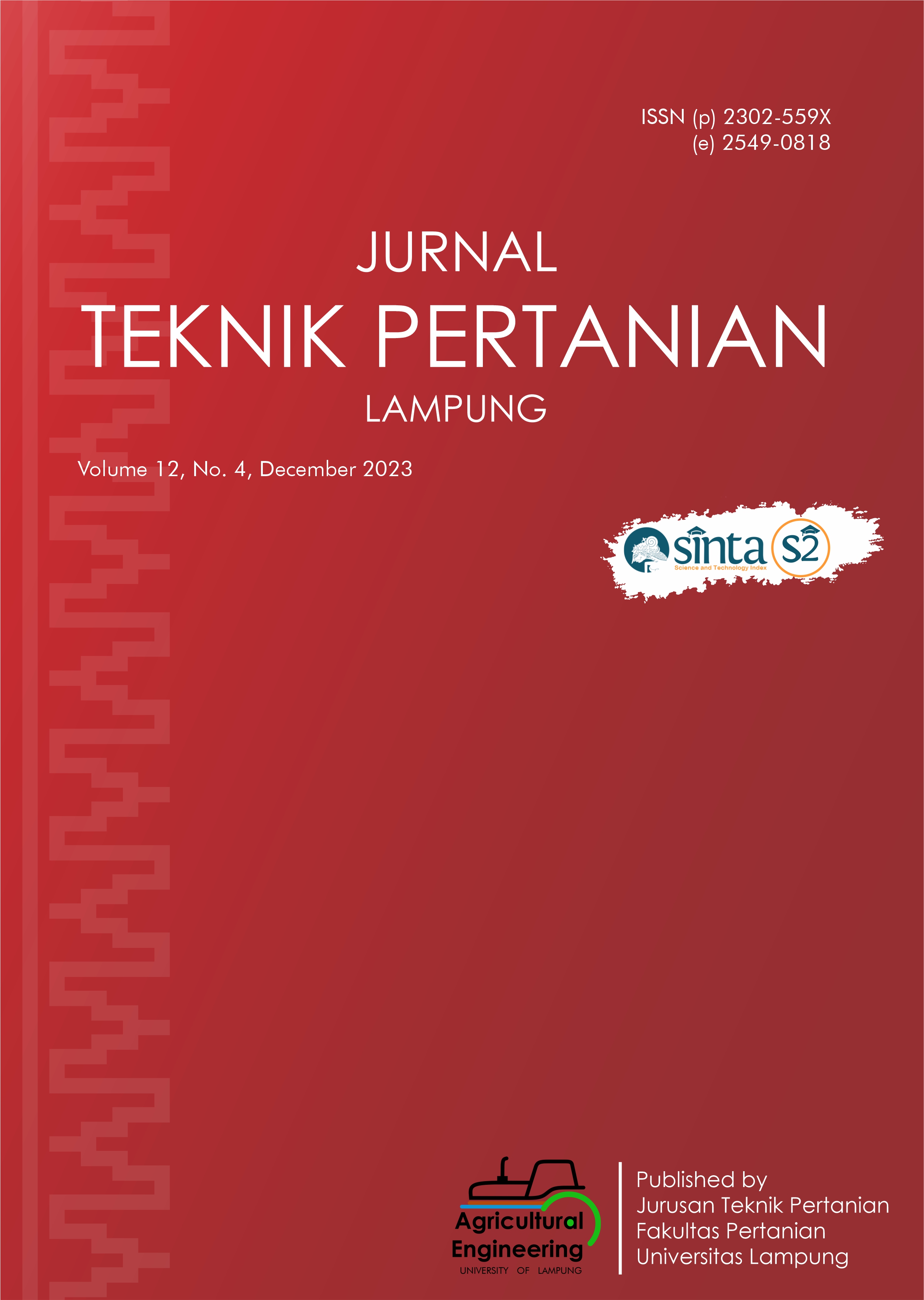Land Suitability Assessments for The Palm Plantation (Arenga pinnata L.) As Non-Timber Forest Product Using Geographic Information System
DOI:
https://doi.org/10.23960/jtep-l.v12i4.957-967Abstract
The use of sugar palm plants as a producer of palm sugar, which is a non-timber forest product (NTFP) is considered not optimal and has the potential to be cultivated. Assessing land suitability is necessary for assessing the potential of land resources to provide information and production values. This study aims to analyze land suitability for sugar palm plantations as measured by climate, land physical properties, and a combination of these parameters. The research was conducted in Baru Ranji Village, Merbau Mataram District, South Lampung Regency, using spatial analysis methods through the use of overlay, matching, and scoring techniques through the Geographic Information System (GIS). The results showed that climatic parameters become limiting factors and only shift the level of land suitability and when combined with the physical parameters, the land was suitable for sugar palm cultivation. The use of agroforestry system in social forestry for sugar palm cultivation can increase economic and environmental conservation value.
Keywords: Agroforestry, Conservation, Cultivated, Palm sugar, Social Forestry
References
Creech, H., Paas, L., Gabriel, G.H., Voora, V., Hybsier, C., & Marquard, H. (2014). Small-scale social-environmental enterprises in the green economy: Supporting grassroots innovation. Development in Practice, 24(3), 366–378. https://doi.org/10.1080/09614524.2014.899561
Guslim. (2007). Agroklimatologi. USU Press, Medan.
Harahap, D.E. (2017). Kajian produktivitas tanaman aren berdasarkan sifat morfologi tanaman pada skuen tinggi tempat di Kabupaten Tapanuli Selatan. Jurnal Pertanian Tropik, 4(2), 161–170. https://doi.org/10.32734/jpt.v4i2.3084
Hardjowigeno, S., & Widiatmaka, W. (2015). Evaluasi Kesesuaian Lahan dan Perencanaan Tataguna Lahan. Gadjah Mada University Press.
Jiru E.B. (2019). Review on agro-forestry system and its contribution in Ethiopia. International Journal of Sustainability Management and Information Technologies, 5(1), 8-14. https://doi.org/10.11648/j.ijsmit.20190501.12
MacDicken, K.G., Sola, P., Hall, J.E., Sabogal, C., Tadoum, M., & de Wasseige, C. (2015). Global progress toward sustainable forest management. Forest Ecology and Management, 352, 47–56. https://doi.org/10.1016/j.foreco.2015.02.005
Malamassam, D. (2020). The management model for sugar palm in educational forest of Universitas Hasanuddin. IOP Conference Series: Earth and Environmental Science, 486, 012108. https://doi.org/10.1088/1755-1315/486/1/012108
Maryudi, A., Devkota, R.R., Schusser, C., Yufanyi, C., Salla, M., Aurenhammer, H., Rotchanaphatharawit, R., & Krott, M. (2012). Back to basics: Considerations in evaluating the outcomes of community forestry. Forest Policy and Economics, 14(1), 1-5 https://doi.org/10.1016/j.forpol.2011.07.017
Mulyanie, M. (2018). Pohon aren sebagai tanaman fungsi konservasi. Jurnal Geografi, 14(2), 11–17.
Novita, N., Saepudin, R., & Sutriyono, S. (2013). Analisis morfometrik lebah madu pekerja Apis cerana budidaya pada dua ketinggian tempat yang berbeda. Jurnal Sain Peternakan Indonesia, 8(1), 41–56. https://doi.org/10.31186/jspi.id.8.1.41-56
Nuraini, C., & Atmaja, U. (2019). Palm sugar agribusiness development strategy in Tasikmalaya Regency. AGRIEKONOMIKA, 8(1), 62–69. https://doi.org/10.21107/AGRIEKONOMIKA.V8I1.5029. G3549
Parker, L., Bourgoin, C., Martinez-Valle, A., & Läderach, P. (2019). Vulnerability of the agricultural sector to climate change: The development of a pan-tropical Climate Risk Vulnerability Assessment to inform sub-national decision making. PLoS ONE, 14(3), 0213641. https://doi.org/10.1371/journal.pone.0213641
Primawan, R. A., & Indrianawati, I. (2018). Analisis kesesuaian lahan sumber daya perkebunan untuk komoditas prospektif di Provinsi Jawa Barat. Reka Geomatika: Jurnal Teknik Geodesi dan Geomatika, 2018(2), 26-34. https://doi.org/10.26760/jrg.v2018i2.2260
Rafi’i, S. (2010). Meteorologi dan Klimatologi. Angkasa, Bandung.
Ritung, S., Wahyunto, Agus, F., & Hidayat, H. (2007). Panduan Evaluasi Kesesuaian Lahan Dengan Contoh Peta Arahan Penggunaan Lahan Kabupaten Aceh Barat. Balai Penelitian Tanah Dan World Agroforestry Centre, Bogor: 39 pp.
Sebayang, L. (2016). Keragaman eksisting tanaman aren (Arenga pinnata Merr) di Sumatera Utara: (Peluang dan Potensi Pengembangannya). Jurnal Pertanian Tropik, 3(2), 133- 138. https://doi.org/10.32734/jpt.v3i2.2967
Vogt, K.A., Honea, J., Vogt, D.J., Andreu, M., Edmonds, R., Sigurdardóttir, R., & Patel-Weynand, T. (2006). Forests and Society: Sustainability and Life Cycles of Forests in Human Landscapes. CABI, Oxfordshire, UK. https://doi.org/10.1079/9781845930981.0000
Widarawati, R., Yudono, P., Indradewa, D., Nuryani, S., & Utami, H. (2017). Sifat dan karakteristik tanah yang memengaruhi pertumbuhan tanaman aren (Arenga pinnata (Wurmb.) Merr). Jurnal Pertanian Agros, 19(1), 55-60.
Wintgens, J.N. (2008). Coffee: Growing, Processing, Sustainable Production: A Guidebook for Growers, Processors, Traders, and Researchers. WILEY-VCH Verlag GmbH & Co. KGaA, Weinheim, Germany. https://doi.org/10.1002/9783527619627
Wirosoedarmo, R., Sutanhaji, A.T., & Kurniati, E. (2012). Land suitability assessment of corn (Zea mays L.) using spasial analysis method. AgriTECH, 31(1), 71–78.
Downloads
Published
Issue
Section
License
- Authors who publish with this journal agree to the following terms:
- Authors retain copyright and grant the journal right of first publication with the work simultaneously licensed under a Creative Commons Attribution-ShareAlike 4.0 International Lice that allows others to share the work with an acknowledgement of the work's authorship and initial publication in this journal.
- Authors are able to enter into separate, additional contractual arrangements for the non-exclusive distribution of the journal's published version of the work (e.g., post it to an institutional repository or publish it in a book), with an acknowledgement of its initial publication in this journal.
- Authors are permitted and encouraged to post their work online (e.g., in institutional repositories or on their website) prior to and during the submission process, as it can lead to productive exchanges, as well as earlier and greater citation of published work (See The Effect of Open Access).
Jurnal Teknik Pertanian Lampung

JTEPL is licensed under a Creative Commons Attribution-ShareAlike 4.0 International License.

